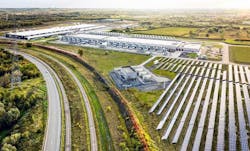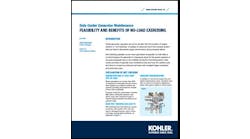Google is using sophisticated new software tools to reduce the carbon impact of its massive data center network, shifting large computing jobs to times where they can be powered with renewable energy.
The Internet giant says this new “carbon intelligent” approach make it easier for giant data center operators to power servers using solar and wind energy, solving complex problems in the availability of renewables. Google’s new approach uses a practice called load shifting that schedules workloads to optimize their resource use.
“Shifting the timing of non-urgent compute tasks — like creating new filter features on Google Photos, YouTube video processing, or adding new words to Google Translate — helps reduce the electrical grid’s carbon footprint, getting us closer to 24×7 carbon-free energy,” writes Ana Radovanovic, Google’s Technical Lead for Carbon-Intelligent Computing, in a blog post.
Google said these changes require no additional computer hardware, and have no impact on the performance of Google services like Search, Maps and YouTube that have huge global audiences.
The announcement, timed to Earth Day 2020, underscores how the recent growth of cloud computing has sharpened the focus on how data centers can retool the economy for a sustainable future. As the COVID-19 pandemic shifts more essential activities online, the carbon impact of the world’s IT infrastructure becomes even more critical in addressing climate change.
Google isn’t alone in this effort. In January Microsoft announced plans to be carbon negative by 2030, and begin tracking the climate impact of its vendors, while Amazon and Apple have procured substantial amounts of renewable energy to support their data centers. Multi-tenant data center developers like Switch, Digital Realty, Aligned and Iron Mountain have also lined up green energy for their data center clients.
Continued Leadership in Sustainability
Sustainability has been a huge priority for Google, which has been a leader in green innovation in the industry. Google has matched its electricity consumption with renewable energy purchases in each of the past three years, purchasing 1.1 gigawatts in 2019. Most of that green energy goes to support Google’s massive network of data centers, which power everything from YouTube videos to Gmail to every query you type into the search field.
Today’s announcement brings Google closer to its goal of using renewable energy to power every hour of operation of its data centers, around the clock and around the globe.
The intermittent nature of renewable energy creates challenges in matching green power to IT operations around the clock. Solar power is only available during daylight hours. Wind energy can be used at night, but not when the wind dies down.
Google says its carbon-intelligent computing platform solves that problem by rescheduling workloads that are not time-sensitive. It can match workloads to solar power during the day, and wind energy in the evening, for example.
“We designed and deployed this first-of-its kind system for our hyperscale (very large) data centers to shift the timing of many compute tasks to when low-carbon power sources, like wind and solar, are most plentiful,” Radovanovic said.
How Google’s Carbon-Aware Computing Works
Google says the platform is now in use at every Google data center, and compares two types of daily forecasts. One is provided by Tomorrow, a climate data firm know for its Electricity Map, and predicts how the average hourly carbon intensity of the local electrical grid will change over the course of a day. Google has also developed an internal tool to predict the hourly power resources that a data center needs to carry out its compute tasks during the same period.
The company then uses the datasets to optimize its operations on an hour-by-hour basis, aligning compute tasks with times of low-carbon electricity supply. Here’s a diagram of what this shift looks like in practice:
This chart shows how Google is shifting workloads throughout the day so its servers will use more renewable energy. (Image: Google)
Google’s carbon-aware platform currently focuses on shifting tasks to different times of the day within the same data center. The company also hopes to move workloads between data centers to boost its use of renewables, a strategy that offers even greater potential gains by shifting data center capacity to locations where green energy is more plentiful, routing around utilities that are slow to adopt renewables.
“Our plan for the future is to shift load in both time and location to maximize the reduction in grid-level CO2 emissions,” Google said.
Google said it will share its methodology and performance results with the industry in upcoming research publications. “We hope that our findings inspire other organizations to deploy their own versions of a carbon-intelligent platform, and together, we can continue to encourage the growth of carbon-free electricity worldwide,” the company said.
Encouraging Broader Adoption of Green Practices
Google has been a leader in two major phases of green innovation in the industry.
In the first phase, Google dramatically improved the efficiency of its data centers, innovating in every aspect of operations, from the chips powering servers to the power infrastructure and cooling systems. Google’s relentless focus on efficiency yielded huge savings in electricity, slashing the amount of carbon needed to operate its Internet business. In 2009 Google began sharing its best practices, allowing others in the industry to improve their efficiency. Annual data center consumption increased by 90 percent from 2000 to 2005, but only by 4 percent from 2010 to 2014, a trend reinforced by recent research.
In the second phase of its sustainability journey, Google’s data center team has focused on procuring renewable energy to power its operations instead of electricity sources based on coal. Google’s use of power purchase agreements (PPAs) for renewable energy has been adopted by other cloud providers and data center REITs.






